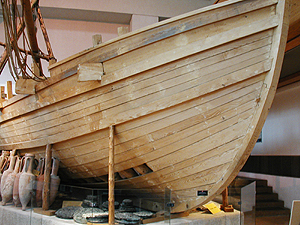The sea route is offered to him. This is the first hypothesis and the one most consistent with our teachings. But the texts indicate something else, a second surprising possibility: Pytheas will follow the tin route, the one that passes through Bordeaux. Nevertheless, this second proposition is not entirely satisfactory.
Could he have made several voyages ?
What do the texts say?
Strabo gives us these indications, the first by quoting Polybius:
« "But Polybius replies that there is something incredible in this itself: that a simple individual, and poor, could have found the means to navigate and travel over such vast spaces." (A1)
"
... This is what Pytheas relates, and that then, having returned from Thule, he would have continued his exploration of all the ocean coasts of Europe, from Gadir (the Pillars of Hercules) to the Tanais."(O62)
Polybius is surprised that Pytheas was able not only to sail (which seems normal to us because he is Greek) but also to travel. We know that Pytheas did not just stop over, but that he also studied the customs of the "barbarians". Did he explore land? This is what the term "sail and travel over such vast spaces" suggests.
On the other hand, Strabo's second text tells us, while he is otherwise more than critical of the Massaliote and does not believe in his writings, "having returned from Thule". Where did he return? To Marseille, his starting point of course. He then explored the coasts of Europe from Cadiz to the Tanais (the Don). Strabo, as usual, does not believe this assertion. At that time the Don was supposed to have its source in the frozen ocean to the North, as the Nile had its source in the Atlantic Ocean.
We therefore believe that Pytheas made two expeditions!
G. Broche, theoretician of Pytheas, addressed this hypothesis in his thesis of 1935, but did not retain it. For him, on his return from Thule, Pytheas stopped in Great Britain, spent the winter there, then continued towards the Tanais. His expedition was unique and was made exclusively by sea from Marseille.
Other historians, such as B. Cunliffe, on the contrary, have Pytheas leave exclusively by the caravan route, not being able to cross the Pillars of Hercules then closely .monitored by the Carthaginians from Cadiz
.
 |
Reconstruction of a penteconter in service at the time of Pytheas. Marseille History Museum |
Why look for a complicated explanation that, in reality, satisfies no one?
Pytheas made two voyages (1):
The first on foot and using a local ship with crew and pilot for transhipments from island to island to Thule. The second with his ship, or his small flotilla, armed by the Republic of Massalia, to explore the coasts of Northern Europe. His first expedition having been made on foot, he did not go through the Pillars of Hercules and it is indeed on the second, by sea, that he explores the coasts of Europe, from the Strait of Gibraltar to the sources of the Tanais.
On his return he wrote two books corresponding to each of his voyages: Description of the Earth and Of the Ocean.
The fact remains that it is not clearly indicated that, on returning from Thule, Pytheas returned to Marseille. We will never know!
We will therefore stick to our initial hypothesis: two expeditions.
* First expedition: The caravan route.
He leaves Massalia around 330-340 BC. By sea he connects Agde, then follows the tin caravan route. A few days later he is in Tolosa (Toulouse), then Bordigala (Bordeaux). The caravans probably take a ship to reach the south of Brittany, and he does the same. He will thus continue his journey across the continent and the islands to Thule. He does not leave with empty pockets. He will have filled the baskets of the caravans with several means of exchange: wine, coral, Greek bronze objects, gold coins, rubies, etc. If for Massalia the objective is commercial, that of Pytheas is scientific: he takes a portable gnomon. This one measures perhaps a meter high. That is 10 times less than that of Massalia. He will thus be able to make his latitude measurements easily without needing a large flat piece of land.
* Second expedition: the edge of Europe.
On his return from Thule, now having a lot of information about the ocean, and knowing that the Phoenicians were already sailing towards the Cassiterides Islands, he did the same and set off for the edge of Europe, the edge of Celtica. The origins of amber still remained to be discovered, and he sought the sources of the Tanais, and why not the northern passage to the Orient.
The republic provided him with one or two ships, with crew. The holds were full of food and means of exchange, and one spring morning he set sail aboard the Artemis. Where did we get this name from? Ferdinand Lallemand gave it to him in "Journal de bord de Pythéas" in 1956.
Imaginary, you think? No doubt, but we like it and as good Marseillais, we keep it.
(1) François Herbaux in " Depuis la terre est ronde" also evokes this idea: two voyages and two books. But in his last book he only goes on foot, along the Rhône and the Loire.

